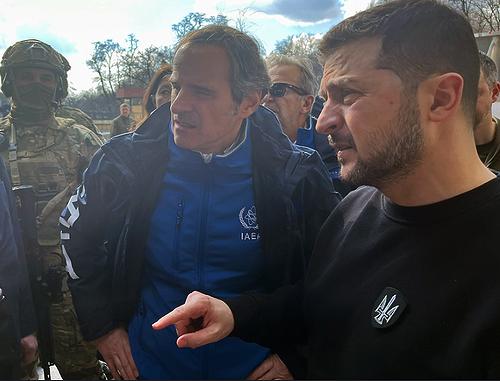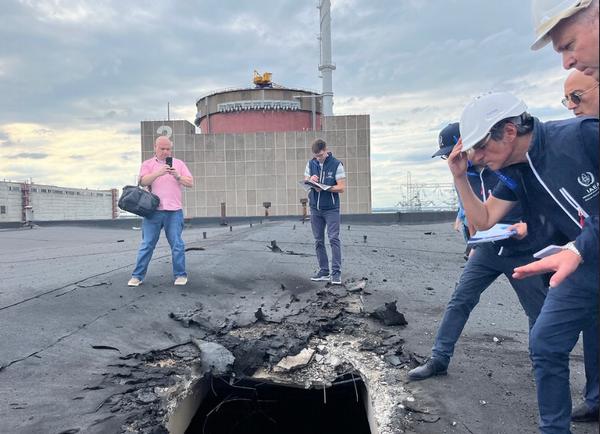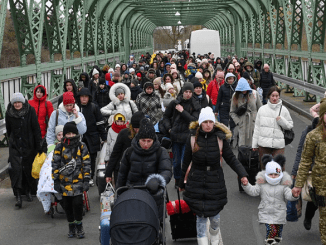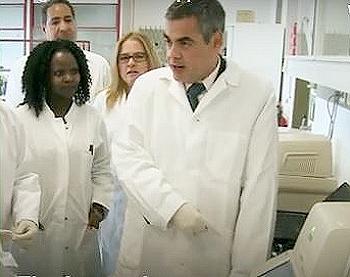
VIENNA, Austria, August 4, 2023 (ENS) – Experts from the International Atomic Energy Agency breathed a sigh of relief when they observed no explosives on the rooftops of nuclear reactor Units 3 and 4 and their turbine halls at Ukraine’s Zaporizhzhya Nuclear Power Plant, ZNPP after alerts from Ukrainian intelligence.
The IAEA was allowed access to the two units on Thursday, the UN agency’s Director General Rafael Mariano Grossi said today. Still, he expressed further safety concerns and said the IAEA will continue its requests to visit the roofs of the other four reactor units at ZNPP.
The plant has been occupied by Russian forces since March 3, 2022. On September 2, 2022, Russia said IAEA inspectors will be allowed to remain permanently at the nuclear plant.
On August 3, following repeated requests, the IAEA team gained unimpeded access to the rooftops of the two reactor Units and could clearly view the rooftops of the turbine halls.
Director General Grossi has stressed the importance of IAEA experts being granted timely access to all areas of the ZNPP to monitor full compliance with the five basic principles for protecting the nuclear power plant during the current military conflict.
Located in southeastern Ukraine 550km (342 miles) from the capital, Kyiv, the ZNPP is the largest nuclear power plant in Europe and among the 10 largest in the world.
“I welcome the news that IAEA experts have finally been granted this additional access at the site. Timely, independent and objective reporting of facts on the ground is crucial to continue the IAEA’s efforts to support nuclear safety and security during the military conflict in the country,” Grossi said.
It was July 4, 2023 when Ukraine’s President Volodymyr Zelensky announced that Russian explosives had been observed on roofs of the ZNPP, triggering alarm around the world, and intensifying IAEA scrutiny even further.
“Now we have information from our intelligence that the Russian troops have placed objects resembling explosives on the roof of several power Units of the Zaporizhzhia nuclear power plant,” President Zelensky said. “Perhaps to simulate an attack on the plant. Perhaps they have some other scenario. But in any case, the world sees – can’t but see – that the only source of danger to the Zaporizhzhia nuclear power plant is Russia and no one else.”
“It is the responsibility of everyone in the world to stop it, no one can stand aside, as radiation affects everyone,” President Zelensky said.
He expressed deep concerns for safety at Zaporizhzhya Nuclear Power Plant even earlier, on July 1 in an interview with Spanish news outlet “El Mundo,” saying, “Ukrainian intelligence is aware of Russian plans to cause a radioactive leak at Zaporizhzhia NPP.
“There are explosives and 5,000 Russian soldiers with heavy weapons at ZNPP. A terrorist attack at the plant is part of their strategy to freeze the conflict. If we hand over control of ZNPP to the IAEA, the Russians will remotely blow up the plant. They need to buy time to make more weapons and then try to erase us from the face of the earth again,” President Zelensky said.

Zelensky accused Russians of kidnapping Ukrainian workers at ZNPP and taking their children to Russia.
Access for the IAEA to the roofs of Units 3 and 4 on Thursday came just after a successful ninth rotation of teams at the plant with IAEA experts once again crossing the front line as the teams departed and arrived at the plant.
On the night before the rotation the IAEA team reported a series of detonations in the vicinity of the plant. ZNPP told the team that there was no impact on the site, the neighboring industrial area, or the city of Enerhodar from these detonations.
But Grossi said the detonations were a reminder of potential nuclear safety and security risks at the six-unit nuclear power plant, now in shutdown mode. “I reiterate my call on all sides to refrain from any action that could lead to a nuclear accident with potential consequences for public health and the environment,” he said.
Dam Destruction Creates Lasting Issues
Due to nearby flooding after shelling and the June 6 breach of the Kakhovka Dam, on June 8, 2023, the sixth ZNPP reactor was put into cold shutdown as a safety precaution. The dam’s destruction was and still is causing depletion of the ZNPP’s main source of cooling water, the Kakhovka Reservoir.
As of July 4, the 750 kV electric grid was reconnected, which the IAEA says ensures routine operations of all ZNPP safety systems in addition to the existing backup sources.
As of mid-July, ZNPP’s Unit 5 was in hot shutdown, a state that the IAEA reported was necessary to produce steam for nuclear safety purposes, including the processing of liquid radioactive waste in storage tanks.
But Unit 5 needed maintenance, and was put in cold shutdown. After Unit 5 reached cold shutdown on July 28, maintenance activities began, including inspection and testing of the safety systems which protect the reactor and its fuel; and cleaning of the heat exchanger, the IAEA said today.
However, the IAEA says its team has repeatedly requested more complete information about the full scope of maintenance activities planned to be conducted on Unit 5, given “the limited availability of spare parts and significantly reduced maintenance staff available at ZNPP.”
Now, the Russian forces occupying ZNPP have ordered another one of the facility’s six reactors into a “hot shutdown” state, a move that violates safety protocols, Ukrainian state-owned nuclear operator Energoatom warns.

Despite the demands of the State Nuclear Regulatory Inspectorate of Ukraine, and also from Energoatom, the company said July 24 that, “at the temporarily occupied Zaporizhzhya nuclear power plant, in compliance with the order of the illegitimate leadership, power Unit No. 4 was put into a ‘hot shutdown” state.”
“Such actions are a gross violation of the requirements of the license to operate this nuclear facility,” Energoatom said. “Currently, [reactor] No. 4 of the ZNPP must be operated exclusively in a ‘cold stop’ state.”
Nonetheless, the IAEA said in a statement today, “It is planned to move Unit 4 from cold to hot shutdown, to allow Unit 5 to be placed in cold shutdown for regular preventative maintenance activities. The IAEA is urging the investigation of whether an external boiler can be installed as an alternative to keeping one Unit in hot shutdown.”
Cooling Water: Crucial Key to ZNPP Safety, Leaking Away
Since the destruction of the Kakhovka Dam, the ZNPP has been relying on water from the site’s cooling pond, the Zaporizhzhya Thermal Power Plant discharge channel, and underground water from the drainage system for its needs.
The height of the water in the ZNPP cooling pond continues to go down at a rate of about one centimeter a day, while the water in the ZTPP discharge channel is periodically being topped up with water that continues to enter the ZTPP inlet channel, primarily from groundwater. There is sufficient water available for many months, the IAEA says.
On August 2, the IAEA team conducted a walkdown of the cooling pond area to examine the integrity of the isolation gate separating the cooling pond from what remains of the Kakhovka Reservoir after the destruction of the downstream dam in June. The team observed that the isolation gate had been reinforced with concrete blocks and soil to a total thickness of up to four metres (13 feet).
Also at the cooling pond, the team visited the location of a pilot well that has been drilled near the port and learned that initial tests of the quality of the water and the groundwater flow rate have been conducted.
If the results of all additional tests are positive, the ZNPP site plans to extend the diameter of the pilot well, to increase the flow rate of water into the well. Once the well is established, the plant will install pumps and piping to provide an alternate supply of water to the sprinkler ponds that provide the essential cooling to the reactor Units.
The team also learned that the site is planning to drill an additional well within the perimeter of the ZNPP site.
Additionally, the IAEA experts performed radiation monitoring of the cooling pond area and the areas inside the site perimeter during the walkdowns. The measurements data are uploaded by the IAEA to the IAEA’s International Radiation Monitoring Information System, IRMIS. All radiation levels were normal.
Separately this week, IAEA teams at the Khmelnitsky, Rivne, and South Ukraine nuclear power plants and the Chernobyl site reported no issues related to nuclear safety and security over the past week.
Site of the world’s world nuclear accident, the Chernobyl Nuclear Power Plant is located about 130 kilometers (81 miles) north of the Ukrainian capital, Kyiv, and about 20 km (12 miles) south of the border with Belarus, according to the World Nuclear Association.
For nearly a year, the global nuclear community has backed IAEA calls for a safety zone at Zaporizhzhia Nuclear Power Plant. “This would include the withdrawal of all military forces from the site and cessation of shelling and military activity in the vicinity of the plant,” said the World Nuclear Association and nuclear industry organizations from the United States, Canada and Europe.
“The global nuclear community supports the continuous presence of the IAEA at the Zaporizhzhia Nuclear Power Plant to ensure the safety of staff and the physical integrity of the plant in the current extreme circumstances,” the nuclear industry said last September. “The agency inspectors should have unrestricted and unmediated access to the operating staff and the areas of the facility to accurately assess conditions at the site.”
The Ukrainian World Congress continues to call on the United Nations and the International Atomic Energy Agency to establish a demilitarized safety zone around the Zaporizhzhia Nuclear Power Plant.
Featured image: International Atomic Energy Agency Director General Rafael Grossi overlooks the sprinkler pond that cools the six units of the Zaporizhzhia Nuclear Power Plant in southeastern Ukraine. June 15, 2023 (Photo by Fredrik Dahl courtesy International Atomic Energy Agency)



